
| myArmoury.com is now completely member-supported. Please contribute to our efforts with a donation. Your donations will go towards updating our site, modernizing it, and keeping it viable long-term.
Last 10 Donors: Anonymous, Daniel Sullivan, Chad Arnow, Jonathan Dean, M. Oroszlany, Sam Arwas, Barry C. Hutchins, Dan Kary, Oskar Gessler, Dave Tonge (View All Donors) |
| Author |
Message |
Sean Flynt

|
 Posted: Fri 16 Jan, 2009 7:27 am Post subject: Italian Shield, ca.1478 Posted: Fri 16 Jan, 2009 7:27 am Post subject: Italian Shield, ca.1478 |
 |
|
From Czerny's, something special to brighten your weekend:
Lot no. 334 A wooden Milanese round shield from the battle of Giornico 1478
category: ARMOUR
provenence: Milan
dating: last quarter of the 15th Century
description: Of round shape, flat, with a slightly oblique border; made of several set wooden parts, covered with pig skin, on the front surface is a black eagle on a gilded background (or a phoenix arising from its ashes), colored arrows on the border, the back surface has remains of the padding and of the buckles, some missing parts on the covering allow to see the shield's structure. Some parts are missing, there are small defects and partial fadings.
note The battle of Giornico took place between the Milanese troops, sent by Gian Galeazzo Sforza to attack the Leventina Valley which represented a constant threat to the dukedom due to the fact that it supported with Swiss Cantons, and the Levantinese and Confederate troops which, according to the tradition, took Milan's armed men by surprise by rolling boulders over them (that's why the battle is also called The Battle of the Big Boulders); the military action of the dukedome was prepared in a great hurry as an act of retaliation because of the siege of Bellinzona by the Swiss; the cause of the ruinous defeat of the Milanese troops - also supported by the Ticino Canton soldiers - is probably due to that, too. In the ruinous retreat they left behind a large number of victims but also weapons and wagons which represented a handsome booty for the winners.
To be confronted with those illustrated in "Le Rotelle Milanesi Bottino della Battaglia di Giornico 1478 - Stemmi, Imprese, Insegne", di Gastone Cambin, Società Svizzera di Araldica, 1987: those in table XVII and XVIII have, respectively, an eagle that is very similar in its style and iconography, and an identical red and white striped border; the similarity of this shield to the ones pictured can be seen also in the same construction (table XXIX, picture n. 73, page 170, while in page 168 are pictured the shields' backs); the typology of this shield is included in the one of the IV group "A PIENO CAMPO shield" listed on page 167.
condition: very good
dimensions: diameter 62,5 cm.
sold: 12500.00 € (starting price 10000.00 €)
 Attachment: 114.32 KB Attachment: 114.32 KB
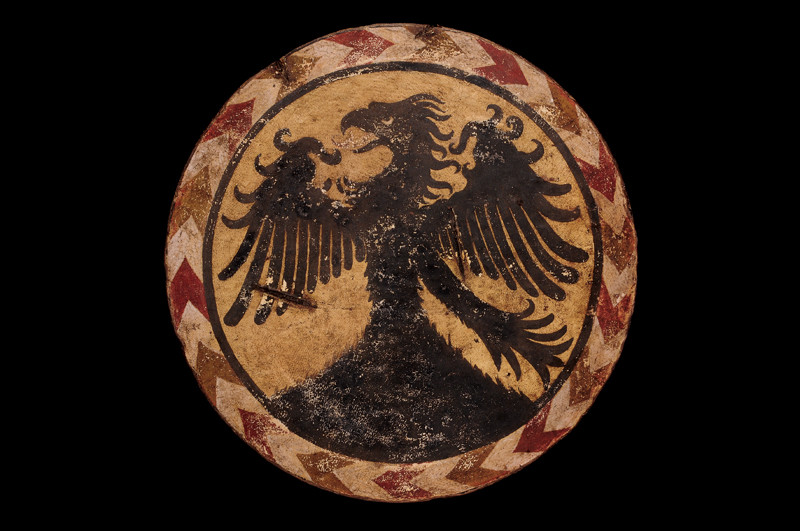
 Attachment: 109.85 KB Attachment: 109.85 KB
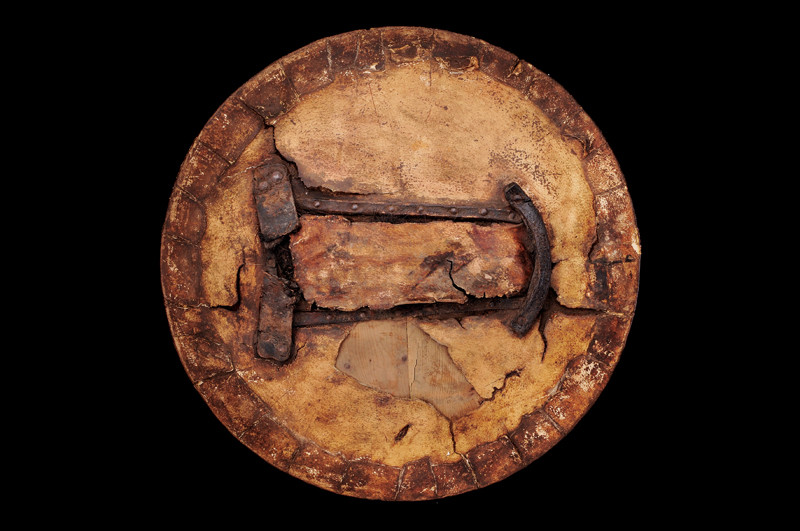
 Attachment: 147.73 KB Attachment: 147.73 KB
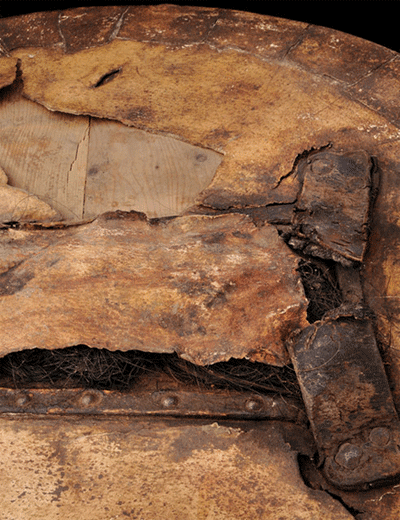
 Attachment: 143.81 KB Attachment: 143.81 KB
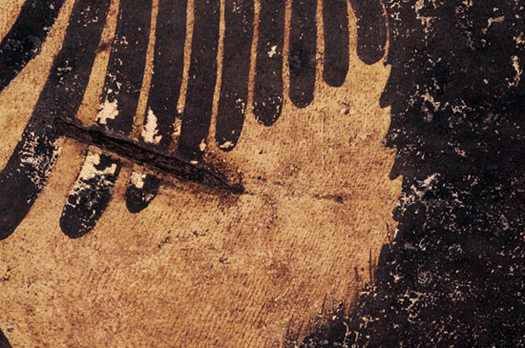
 Attachment: 145.92 KB Attachment: 145.92 KB
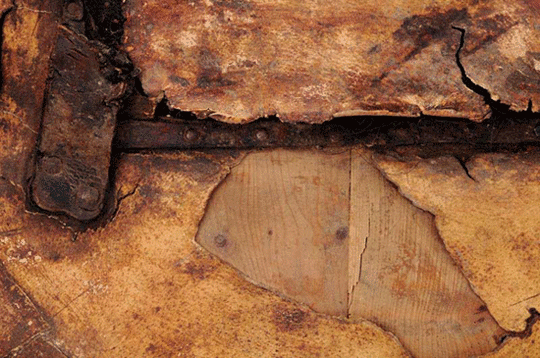
-Sean
Author of the Little Hammer novel
https://www.amazon.com/Little-Hammer-Sean-Flynt/dp/B08XN7HZ82/ref=sr_1_1?dchild=1&keywords=little+hammer+book&qid=1627482034&sr=8-1
|
|
   |
 |
Steven Reich

Location: Arlington, VA Joined: 28 Oct 2003
Posts: 237
|
 Posted: Fri 16 Jan, 2009 8:35 am Post subject: Posted: Fri 16 Jan, 2009 8:35 am Post subject: |
 |
|
Are there any stats (i.e. weight, diameter, thickness, etc.)?
What a fantastic piece.
Steve
Founder of NoVA-Assalto, an affiliate of the HEMA Alliance
|
|
   |
 |
Sean Flynt

|
 Posted: Fri 16 Jan, 2009 8:53 am Post subject: Posted: Fri 16 Jan, 2009 8:53 am Post subject: |
 |
|
Only the "62.5 cm" figure given in the text, but at least we can break that down into a useful scale to measure other features (maybe break it down to the width between two of those rivets on the "arm" since those are visible in some of the detail shots. Like me, you're probably craving the depth dimension, and that must be speculative, based on later targets. Not clear, either, if there are two layers of boards, as in British targets.
-Sean
Author of the Little Hammer novel
https://www.amazon.com/Little-Hammer-Sean-Flynt/dp/B08XN7HZ82/ref=sr_1_1?dchild=1&keywords=little+hammer+book&qid=1627482034&sr=8-1
|
|
   |
 |
|
Chris Arrington
|
 Posted: Fri 16 Jan, 2009 8:58 am Post subject: Posted: Fri 16 Jan, 2009 8:58 am Post subject: |
 |
|
Very Nice !
The Eagle looks very Germanic to me, not Milanese, but that is hardly conclusive. Opinons mean nothing 
A good counter thought to that, is that if you assumed anything with a fluer de lis on it was French, you would be very wrong!
Love it.
|
|
  |
 |
Sean Flynt

|
 Posted: Fri 16 Jan, 2009 10:08 am Post subject: Posted: Fri 16 Jan, 2009 10:08 am Post subject: |
 |
|
| Chris Arrington wrote: | Very Nice !
The Eagle looks very Germanic to me, not Milanese, but that is hardly conclusive. Opinons mean nothing 
A good counter thought to that, is that if you assumed anything with a fluer de lis on it was French, you would be very wrong!
Love it. |
Northern Italy/Southern Austrial/Southern Germany--I assume there was a bit of cultural borrowing in the region. Plus there is some thought that this is a phoenix, rising from its ashes (which gives me an idea for a plume holder I was already planning).
-Sean
Author of the Little Hammer novel
https://www.amazon.com/Little-Hammer-Sean-Flynt/dp/B08XN7HZ82/ref=sr_1_1?dchild=1&keywords=little+hammer+book&qid=1627482034&sr=8-1
|
|
   |
 |
|
Chris Arrington
|
 Posted: Fri 16 Jan, 2009 10:25 am Post subject: Posted: Fri 16 Jan, 2009 10:25 am Post subject: |
 |
|
|
Is that battle damage on the front?
|
|
  |
 |
Sean Flynt

|
 Posted: Fri 16 Jan, 2009 10:52 am Post subject: Posted: Fri 16 Jan, 2009 10:52 am Post subject: |
 |
|
| Chris Arrington wrote: | | Is that battle damage on the front? |
Ordinarily, I'd be deeply skeptical of claims of battle damage. In this case, the preservation is amazing, the piece apparently is a documented trophy of the described battle (so went straight into an armoury or private residence?,) Czerny's makes no overt claims about the damage and there's an almost identical vertical cut parallel with the feathers of the bird's left wing, near the body. There are short cuts to the edge at the 11 and 12 o'clock positions as well. I think all of that makes a stronger case for this being battle damage.
-Sean
Author of the Little Hammer novel
https://www.amazon.com/Little-Hammer-Sean-Flynt/dp/B08XN7HZ82/ref=sr_1_1?dchild=1&keywords=little+hammer+book&qid=1627482034&sr=8-1
|
|
   |
 |
Leo Todeschini
Industry Professional

|
|
   |
 |
Sean Flynt

|
 Posted: Fri 16 Jan, 2009 12:00 pm Post subject: Posted: Fri 16 Jan, 2009 12:00 pm Post subject: |
 |
|
| Leo Todeschini wrote: | I I have just discovered that I know one thing about this shield for sure and it is that I am going to make a copy of it.
I am in love
Tod |
That's a strong interest for me as well. Tod, does it look to you like the edge (the entire area of white w/red chevrons) slopes down slightly from the black-painted ring? It may just be an optical illusion caused by the chevrons. And what would you guess about max. body depth--.75"?
By the way, I've reduced/cropped some of these photos to get them small enough to post here. See the Czerny's site for better detail.
-Sean
Author of the Little Hammer novel
https://www.amazon.com/Little-Hammer-Sean-Flynt/dp/B08XN7HZ82/ref=sr_1_1?dchild=1&keywords=little+hammer+book&qid=1627482034&sr=8-1
|
|
   |
 |
Leo Todeschini
Industry Professional

|
 Posted: Fri 16 Jan, 2009 3:07 pm Post subject: Posted: Fri 16 Jan, 2009 3:07 pm Post subject: |
 |
|
I can see what you are getting at, but that would be quite a dramatic bend to be visible over really a very short distance from the black to the edge and also it would be very hard to get it uniform as the grain direction changes round the rim. So I suspect that it is flat.
As to thickness, I don't know but as a guess I go with you. I made a shield a while back that was about 15mm 5/8" thick and with the leather front face ended up about 18mm 3/4" at about 36" diameter rather than the 25" of this one and it was clearly way too heavy and in fact as a viking age one, it should really have been out of 7-8mm board. I made it thicker because I was sure that the stats must have been wrong on Viking age shields but clearly they were not. This one has half the area of that and so at 15mm plus a facing, it would be half the weight and that would be viable.
Before anyone asks I didn't have weights on the one I made, so all I can say is that 3/4" of wood, at 25" and I would guess cross ply would be both effective at stopping blows without disintegrating too readily and would also be manageable in terms of weight. The wood looks like a pine, but not the speed grown pap we have to suffer these days, so a pine worth having.
What is also interesting is the rather crude wrapping of the front cover over the rear face and glueing in place, they have even slit the leather to make it wrap round easier rather than press it into shape, so a nice piece from the front, but rather crudely executed from the back. The money was definitely put into the side to impress.
Tod
www.todsworkshop.com
www.todcutler.com
www.instagram.com/todsworkshop
https://www.facebook.com/TodsWorkshop
www.youtube.com/user/todsstuff1
|
|
   |
 |
Leo Todeschini
Industry Professional

|
|
   |
 |
D. Austin
Industry Professional

Location: Melbourne, Australia Joined: 20 Sep 2007
Posts: 208
|
 Posted: Fri 16 Jan, 2009 3:38 pm Post subject: Posted: Fri 16 Jan, 2009 3:38 pm Post subject: |
 |
|
Could it be three layers of ply, the middle one running horizontally? I'm not sure that the iron strips are sufficient to hold those slats together otherwise.
Regarding the edge sloping down, the description does say:
| Quote: | | flat, with a slightly oblique border |
To me that suggests that you''re right Sean as I'm not sure how else to interpret that quote.
Thanks for posting this. It's not often one sees such a thing.
Darren.
|
|
  |
 |
|
Lawrence Parramore
|
 Posted: Sat 17 Jan, 2009 7:33 am Post subject: Posted: Sat 17 Jan, 2009 7:33 am Post subject: |
 |
|
|
Some people think that the wood is a modern replacement, the shield was restored recently I believe.
|
|
  |
 |
|
Michael S. Rivet
|
 Posted: Sat 17 Jan, 2009 7:53 am Post subject: Posted: Sat 17 Jan, 2009 7:53 am Post subject: |
 |
|
| D. Austin wrote: | | Could it be three layers of ply, the middle one running horizontally? I'm not sure that the iron strips are sufficient to hold those slats together otherwise. |
Why not? It's not that different from Viking shield construction.
|
|
  |
 |
D. Austin
Industry Professional

Location: Melbourne, Australia Joined: 20 Sep 2007
Posts: 208
|
 Posted: Sat 17 Jan, 2009 4:13 pm Post subject: Posted: Sat 17 Jan, 2009 4:13 pm Post subject: |
 |
|
|
If it was made from say, four vertical strips of wood of equal width, the edge ones wouldn't have a lot of steel overlapping them. I don't know much about period woodwork but I guess that glue, pins, other vertical laminations etc could provide the strength needed.
|
|
  |
 |
Leo Todeschini
Industry Professional

|
 Posted: Sun 18 Jan, 2009 11:52 am Post subject: Posted: Sun 18 Jan, 2009 11:52 am Post subject: |
 |
|
| Quote: | D. Austin wrote:
Could it be three layers of ply, the middle one running horizontally? I'm not sure that the iron strips are sufficient to hold those slats together otherwise.
|
| Quote: |
Michael S Rivet wrote
Why not? It's not that different from Viking shield construction. |
I am by no means a shield or especially a Viking shield expert, but all the evidence I have is that Viking shields were almost disposable single use items and that they were made from 6-8mm thick (around 1/4") pine boards that were in a single ply and butt glued without tongue and groove or similar and may or may not have had reinforcing strips on them and are likely to have had some rim reinforcing such as a metal or rawhide band.
Basically they seemed to be made in a way that I feel I could punch through them. Which is why I made my first Viking shield well overweight because it seemed so wrong. Altogether curios.
I believe that crossply was more common by the middle ages and clearly makes a better shield.
| Quote: | Lawrence Parramore wrote
Some people think that the wood is a modern replacement, the shield was restored recently I believe. |
14,000 Euros is enough to make you take some time over a repair, and I am not a restorer, but I do know leather and to open that shield up, and replace the wood in it and put it together again would take a magician. I cannot see how that wood is not original to the piece.
Tod
www.todsworkshop.com
www.todcutler.com
www.instagram.com/todsworkshop
https://www.facebook.com/TodsWorkshop
www.youtube.com/user/todsstuff1
|
|
   |
 |
Bruno Giordan

|
 Posted: Sun 18 Jan, 2009 2:50 pm Post subject: Posted: Sun 18 Jan, 2009 2:50 pm Post subject: |
 |
|
The piece was discussed at armsandarmourforum.com, some people doubt of its authenticity.
It is part of a batch of numerous surviving rotelle from the battle of Giornico, many are still preserved in Switzerland, but they have a patina this piece doesn't have.
here paint is bright and leather (apparently pork) is clean, so i thought it could be a restored piece.
Restorers in italian museums are accustomed to transfer paintings from a surface to another, this would be possible for high level ones.
Also, the edges of this piece are glued while other originals showed in the td at armsandarmourforum had nailed edges.
i would swear the glue that appears on this edges is vinavil ...
Confronting this with the pics of other surviving pieces should give an idea of what i mean, this shield appears quite a bit different and many people at the other forum had suspects about its authenticity.
The other ones are not restored, though.
I'm sure this is (regardless of a transplant of the painted skin) because of its bright and neat colors, the absence of any patina and efflorescence as it is visible on the others.
So it could be authentic and its colors would be quite close to their original state.
here we have decent but low res details of the other rotelle
http://www.ugopozzati.it/Rotelle-Milanesi.htm
|
|
  |
 |
Leo Todeschini
Industry Professional

|
|
   |
 |
|
Michael S. Rivet
|
 Posted: Mon 19 Jan, 2009 8:20 am Post subject: Posted: Mon 19 Jan, 2009 8:20 am Post subject: |
 |
|
| Leo Todeschini wrote: | I am by no means a shield or especially a Viking shield expert, but all the evidence I have is that Viking shields were almost disposable single use items and that they were made from 6-8mm thick (around 1/4") pine boards that were in a single ply and butt glued without tongue and groove or similar and may or may not have had reinforcing strips on them and are likely to have had some rim reinforcing such as a metal or rawhide band.
Basically they seemed to be made in a way that I feel I could punch through them. Which is why I made my first Viking shield well overweight because it seemed so wrong. Altogether curios.
I believe that crossply was more common by the middle ages and clearly makes a better shield. |
I'd be curious to see the evidence that Viking shields were "disposable." I've been looking for evidence of that and have found little enough to make me doubt it strongly. At any rate, this isn't the thread to discuss it. If you can point me to any particular evidence, please PM me.
As for the medieval shield, it was used differently, and I've read that they were cross-ply as well. Then again, I've seen images of examples that apparently weren't. If I recall, there are pictures of two heater-shaped shields in "Arms and Armor of the Medieval Knight." At least one is described as being formed from three vertical planks. No mention of reinforcement or cross-ply. So it's possible that some were made from a single layer even in the medieval period and held together mainly by the straps, facing, and occasionally edging, much as their Viking forbears were. We know so little about how some of these shields were used that we may sometimes assume they need to be more rugged than they really were.
|
|
  |
 |
Bruno Giordan

|
 Posted: Mon 19 Jan, 2009 10:32 am Post subject: Posted: Mon 19 Jan, 2009 10:32 am Post subject: |
 |
|
| Chris Arrington wrote: | Very Nice !
The Eagle looks very Germanic to me, not Milanese, but that is hardly conclusive. Opinons mean nothing 
A good counter thought to that, is that if you assumed anything with a fluer de lis on it was French, you would be very wrong!
Love it. |
Plus we were under a German emperor, at least nominally .... most families traced their nobility to Germany (in broad sense) or had received it from the Emperor, who was a German for us during the middle age.
|
|
  |
 |
|
|
You cannot post new topics in this forum
You cannot reply to topics in this forum
You cannot edit your posts in this forum
You cannot delete your posts in this forum
You cannot vote in polls in this forum
You cannot attach files in this forum
You can download files in this forum
|
All contents © Copyright 2003-2024 myArmoury.com — All rights reserved
Discussion forums powered by phpBB © The phpBB Group
Switch to the Basic Low-bandwidth Version of the forum
|

